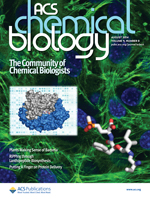

Main navigation | Main content

In work published in ACS Chemical Biology [ACS Chem. Biol., 2014, 9 (8), 1726–1735] and featured on the cover, graduate student Yen-Chih Wang [who recently earned his doctorate] in the research group of Professor Mark Distefano developed a method for synthesizing and screening libraries of hundreds of peptide sequences as potential substrates for protein farnesyltransferase (PFTase). That enzyme catalyzes the transfer of farnesyl groups to a large number of proteins involved in signal transduction pathways that are critical for cellular function. Because of their central role in modulating cellular behavior, prenylated proteins are important targets for the development of new therapeutic agents that can intervene in cancer, protozoan diseases and bacterial and viral infections.
In this recent work, Wang developed a solid phase strategy using cellulose membranes (SPOT synthesis) that incorporated multiple degrees of orthogonal protection to allow the peptide sequences to be inverted on the resin and released via photochemical cleavage to yield peptide libraries containing 600 different sequences. The libraries were screened by detecting the enzymatic transfer of an alkyne-containing analogue of farnesyl diphosphate via click reaction with biotin azide followed by a streptavidin-alkaline phosphatase colorimetric reaction. Screening of CVa2X and CCa2X libraries (based on the canonical recognition sequence Ca1a2X for PFTase) where C and V residues were incorporated in the a1 position with R. norvegicus PFTase revealed reaction by many known recognition sequences as well as numerous unknown ones. Some of the latter occur in the genomes of bacteria and viruses and may be important for pathogenesis, suggesting new targets for therapeutic intervention. Screening of the CVa2X library with alkyne-functionalized isoprenoid substrates showed that those prepared from C10 or C15 precursors gave similar results, whereas the analogue synthesized from a C5 unit gave a different pattern of reactivity. Lastly, the substrate specificities of PFTases from three organisms (R. norvegicus, S. cerevisiae, and C. albicans) were compared using CVa2X libraries. R. norvegicus PFTase was found to share more peptide substrates with S. cerevisiae PFTase than with C. albicans PFTase. In general, this method is a highly efficient strategy for rapidly probing the specificity of this important enzyme.